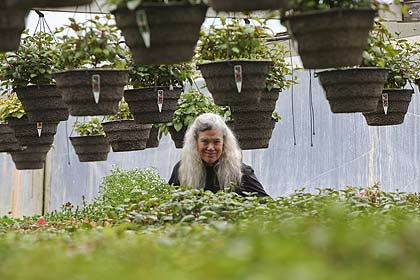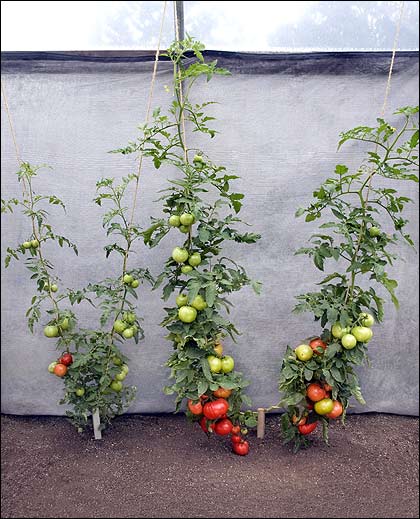Digs: EW’s guide to green homes & gardens
Farms Not Lawns Defense against divisions in your own back 40
Low VOCs for My Undies Refinishing furniture the low-toxic way
Green Digs LCC offers low-carbon, car free living downtown
Green on Top Great for the environment, wallet, health and wellbeing
Where To Find Used Home & Garden Materials
Super Natural Veggies
Grafted tomatoes are out of this world
By Rachel Foster
When Alice Doyle invited me out to Log House Plants in Cottage Grove late last summer to see the nurserys latest innovation, the whole idea of grafted vegetables was alien to me. Im familiar with grafting in the context of woody plants, as when a piece of top growth (called a scion) from a desirable apple variety is grafted on the roots of a related, smaller growing plant to restrict its growth or increase its vigor.û
 |
| Ordinary big beefû tomato plant (left), mighty *mato big beef tomato plant (right). © 2010 by Robin Bachtler Cushman – All Rights Reserved |
 |
| Alice Doyle |
Well, evidently you can do the same thing with non-woody plants, including veggies. And, surprise, surprise, the technique has been around for the best part of a century ‹ ever since Asian growers found that grafting watermelons onto the roots of squash or gourd plants increased their resistance to fusarium wilt. Eighty-one percent of Korean and 54 percent of Japanese vegetables are now grown this way.
Grafting on appropriate rootstock helps plants resist disease and tolerate environmental stresses. Since the 1960s, grafting vegetables has spread to Europe, Israel and around the world, wherever land is scarce or marginal, or loaded with diseases from long cultivation. In the U.S., grafting holds particular promise for organic farmers, who do not use soil fumigation or other techniques involving potentially harmful chemicals. And using a disease-resistant, more vigorous rootstock produces larger yields, even in good soils.û
Because tomatoes are susceptible to a wide variety of soil-borne diseases, they are particularly good candidates for grafting. On that visit to Log House Plants, I saw identical varieties of tomatoes, with and without grafting, growing side by side. The vigor of the grafted plants, the size of the fruit and the abundance of the crop were seriously impressive. And, in case you were wondering, those big tomatoes were every bit as tasty as the smaller fruit from plants on their own roots.û
People love heirloom tomatoes for their varied shapes and colors and, above all, their superior flavor. But heirloom varieties often lack the disease resistance of modern hybrids. Last year, Log House Plants (a wholesale nursery) shipped a few varieties of grafted heirloom tomatoes ‹ the first grafted tomato plants commercially available to American gardeners ‹ to independent retail stores around the Northwest.û
This year, Log House is introducing a whole new line of hand grafted tomatoes under the name øSuperNaturals Mighty Mato.” Mighty Mato will soon be joined by grafted peppers, eggplant and squash. Doyle explains: øAs we make more kinds of grafted vegetables available, the entire line will be called SuperNaturals Grafted Vegetables: super plants with exceptional fruit flavor, quality and yield. But grafting strengthens the variety in a way that is still natural, without genetic modification or strong chemicals.”
Grafting is a delicate operation that must be done in a carefully controlled environment. In a special room at Log House Plants, tomatoes are grafted early, when scion and rootstock plants have just two to four true leaves. The little plants must have stems of similar diameter, so the vascular tissue (which moves a plants fluid and nutrients) will line up.û
Cuts are made at 45 degrees, just below the seed leaves. Once the scion and root stock plant are lined up and secured with a special clip, they go into a healing chamber that regulates temperature, humidity and light to create the best conditions for the tissues to mend and grow together. After a week or two in the greenhouse, they are ready to go into the garden.û
Territorial Seed Company was granted a ømail-order seed company exclusive” for Log House Plants line of grafted vegetables for 2011. Plants are also available through Garden Life, a radio show broadcast in 50 cities in the U.S that markets garden products. øEach outlet has different varieties and sizes. Territorials grafted is in 2 inch (pots) only, Garden Life is in 4 inch only,” Doyle says. øOur accounts in Oregon, Washington and California will be offered SuperNaturals Grafted Vegetables ‹ mainly the Mighty *Mato ‹ in 4 inch pots mid April through June 1, and in gallons and 4 inch June and July.”û
Those stores will also be offered a limited quantity of grafted eggplant and grafted peppers, with vintage SuperNaturals names, of course. If you decide to give these superplants a try, handle them carefully to protect the graft, and dont plant them extra deep, as you may with ordinary, ungrafted starts. You need to make sure the graft remains above soil level. Remove any suckers that appear below the graft, and pinch out side shoots carefully to minimize excess foliage. The plants will need sturdy support, too. Tying the plants to a piece of welded wire fencing fixed to strong posts would be a good strategy.û
Rachel Foster of Eugene is a garden writer and consultant. She can be reached at rfoster@efn.org